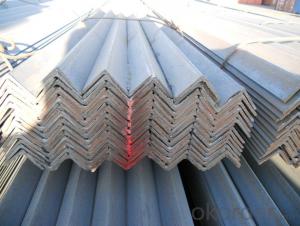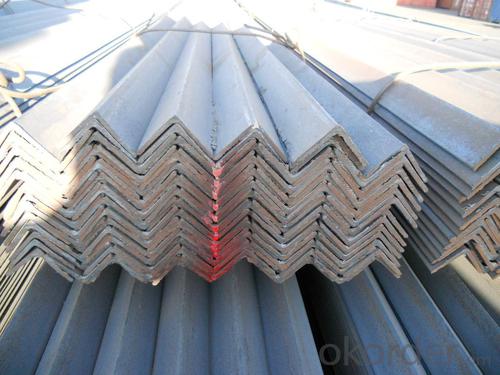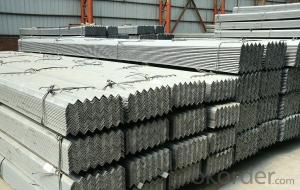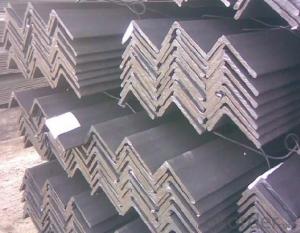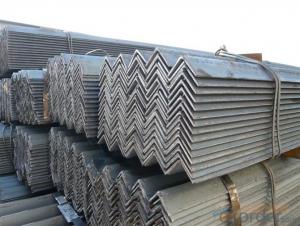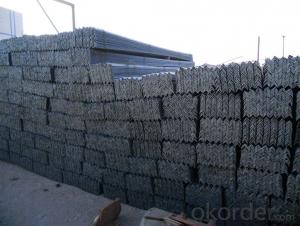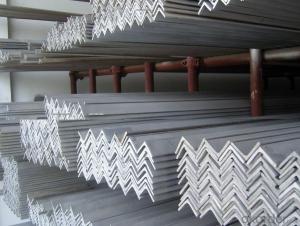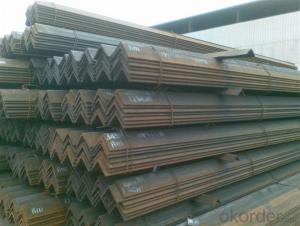GB Q345 Steel Angle with High Quality 65*65mm
- Loading Port:
- Tianjin
- Payment Terms:
- TT or LC
- Min Order Qty:
- 25 m.t
- Supply Capability:
- 10000 m.t/month
OKorder Service Pledge
OKorder Financial Service
You Might Also Like
Specifications of GB Q345 Steel Angle with High Quality 65*65mm:
1.Standards: GB
2.Material: Q345 or Equivalent
3.Length: 6m, 12m
4.Size:
| Size (mm) | Mass (kg/m) | Size (mm) | Mass (kg/m) |
| 65*65*5 | 4.907 | 65*65*8 | 7.662 |
| 65*65*6 | 5.841 |
Usage & Applications of GB Q345 Steel Angle with High Quality 65*65mm:
Trusses;
Transmission towers;
Telecommunication towers;
Bracing for general structures;
Stiffeners in structural use.
Packaging & Delivery of GB Q345 Steel Angle with High Quality 65*65mm:
1. Transportation: the goods are delivered by truck from mill to loading port, the maximum quantity can be loaded is around 40MTs by each truck. If the order quantity cannot reach the full truck loaded, the transportation cost per ton will be little higher than full load.
2. With bundles and load in 20 feet/40 feet container, or by bulk cargo, also we could do as customer's request.
3. Marks:
Color mark: There will be color marking on both end of the bundle for the cargo delivered by bulk vessel. That makes it easily to distinguish at the destination port.
Tag mark: There will be tag mark tied up on the bundles. The information usually including supplier logo and name, product name, made in China, shipping marks and other information request by the customer.
If loading by container the marking is not needed, but we will prepare it as customers' request.
FAQ:
Q1: Why buy Materials & Equipment from OKorder.com?
A1: All products offered byOKorder.com are carefully selected from China's most reliable manufacturing enterprises. Through its ISO certifications, OKorder.com adheres to the highest standards and a commitment to supply chain safety and customer satisfaction.
Q2: How do we guarantee the quality of our products?
A2: We have established an advanced quality management system which conducts strict quality tests at every step, from raw materials to the final product. At the same time, we provide extensive follow-up service assurances as required.
Q3: How soon can we receive the product after purchase?
A3: Within three days of placing an order, we will arrange production. The shipping date is dependent upon the quatity, how many sizes you want and the plan of production, but is typically 30 to 45 days from the beginning of production.
Images of GB Q345 Steel Angle with High Quality 65*65mm:

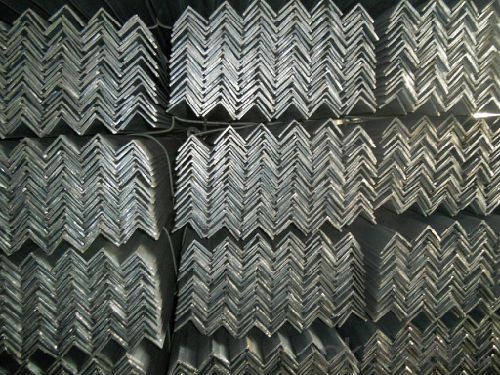
*If you would like to get our price, please inform us the size, standard/material and quantity. Thank you very much for your attention.
- Q: What is the cost of a steel angle?
- The price of a steel angle may differ based on various factors including its size, grade, thickness, and the supplier or manufacturer chosen. Typically, steel angles are priced either per length or per weight. When determining the cost, it is crucial to take into account the market situation, location, and specific requirements of the desired steel angle. To obtain precise and current pricing details, it is advisable to reach out to local suppliers or manufacturers.
- Q: Can steel angles be used in HVAC systems?
- Indeed, HVAC systems can incorporate steel angles. Renowned for their robustness and longevity, steel angles find widespread application in the construction sector. Within HVAC systems, steel angles serve diverse roles. They function as ductwork supports, guaranteeing stability and correct installation. Moreover, they can serve as brackets or frames, facilitating the mounting of essential equipment like fans, compressors, or condensers. Furthermore, steel angles prove invaluable in fabricating air handling units and other HVAC components. Their inflexibility and capacity to endure elevated temperatures render them ideal for deployment in HVAC systems.
- Q: How to determine the neutral axis of the angle bar?
- The neutral axis of angle iron or channel steel needs to be calculated, but it can be checked directly.
- Q: Can steel angles be used in the construction of conveyor systems?
- Yes, steel angles can be used in the construction of conveyor systems. Steel angles are commonly used as structural components in conveyor systems due to their strength, durability, and versatility. They can be utilized to provide support, reinforcement, and stability to the conveyor structure. Steel angles can be easily welded or bolted together to create a rigid framework for the conveyor system. They can also be used to create adjustable legs or brackets to accommodate different conveyor heights or angles. Additionally, steel angles can be fabricated and customized to meet specific design requirements, making them a suitable choice for conveyor system construction.
- Q: Can steel angles be used for staircases or handrails?
- Yes, steel angles can be used for staircases or handrails. Steel angles provide structural support and can be used to create sturdy and durable staircases and handrails. They are commonly used in construction for their strength and versatility.
- Q: What are the common design codes or standards for steel angles?
- There are several common design codes and standards that govern the use of steel angles in structural design. These codes and standards ensure that the angles are designed and manufactured to meet certain safety and performance criteria. One of the most widely used design codes for steel angles is the American Institute of Steel Construction (AISC) Manual of Steel Construction. The AISC provides comprehensive guidelines and specifications for the design, fabrication, and erection of steel structures, including angles. This manual includes detailed information on the design strength, allowable stress levels, and geometric properties of angles. In addition to the AISC Manual, other design codes and standards may also be applicable depending on the specific project and location. These include international standards such as the Eurocode, British Standards (BS), and Australian Standards (AS). Each of these standards may have slightly different requirements for the design and use of steel angles, so it is important to consult the appropriate standard for the specific project. Furthermore, the American Society for Testing and Materials (ASTM) has established standards for the physical and mechanical properties of steel angles. These standards ensure that the angles meet certain quality and performance requirements. The most commonly used ASTM standard for steel angles is ASTM A36, which specifies the general requirements for carbon structural steel. Overall, the common design codes and standards for steel angles provide guidance on factors such as load capacity, strength, and safety considerations. Adhering to these codes and standards ensures that steel angles are designed and used in a manner that promotes structural integrity and reliability.
- Q: How much is a galvanized angle L50*50*5*2500
- Probably around 40 yuan
- Q: What are the different methods of surface cleaning for steel angles?
- Some different methods of surface cleaning for steel angles include mechanical cleaning through techniques like sandblasting or wire brushing, chemical cleaning using solvents or acids, and electrochemical cleaning through processes like electrolysis.
- Q: What are the different methods for protecting steel angles from corrosion?
- There are multiple ways to safeguard steel angles from corrosion. Firstly, galvanization is a commonly employed technique. It involves applying a layer of zinc to the steel angle's surface. This zinc layer acts as a sacrificial anode, corroding before the steel and safeguarding it from rust. Galvanization is particularly effective in outdoor applications like construction and infrastructure projects. Another method is using paint coatings. By coating the steel angle with paint, a protective layer is formed, preventing moisture and oxygen from reaching the surface and hindering corrosion. For long-term protection, it is crucial to use high-quality, corrosion-resistant paints. Powder coating is also an option. It entails applying a dry powder to the steel angle which is then cured at high temperatures. This creates a robust and durable layer on the surface, offering exceptional resistance to corrosion. Powder coating is suitable for both indoor and outdoor applications and provides an appealing finish. Furthermore, stainless steel angles can be utilized to guard against corrosion. Stainless steel contains chromium, which forms a passive oxide layer on the surface, acting as a protective barrier. This makes stainless steel highly resistant to rust, making it a preferred choice when corrosion is a concern. Lastly, cathodic protection is a technique that involves making the steel angle the cathode in a corrosion cell. This can be achieved by connecting the steel angle to a sacrificial anode, such as zinc or aluminum, or by employing impressed current systems. By doing so, the anode corrodes instead of the steel, effectively protecting it from corrosion. It is important to consider various factors, including the intended application, environmental conditions, and budget constraints when selecting the appropriate method for protecting steel angles from corrosion. Consulting corrosion experts and considering project-specific requirements is advisable to ensure the most suitable method is chosen.
- Q: Are steel angles available in custom sizes?
- Yes, steel angles are available in custom sizes. Steel angles are commonly used in construction and manufacturing industries, and they come in various standard sizes. However, if the standard sizes do not meet the specific requirements of a project, custom sizes can be manufactured. This allows for greater flexibility in designing and building structures or products. Custom-sized steel angles can be fabricated by cutting and reshaping standard angles or by manufacturing them from scratch according to the desired dimensions.
Send your message to us
GB Q345 Steel Angle with High Quality 65*65mm
- Loading Port:
- Tianjin
- Payment Terms:
- TT or LC
- Min Order Qty:
- 25 m.t
- Supply Capability:
- 10000 m.t/month
OKorder Service Pledge
OKorder Financial Service
Similar products
Hot products
Hot Searches
Related keywords
